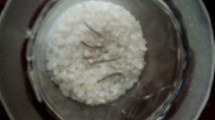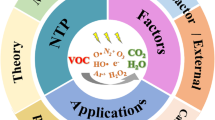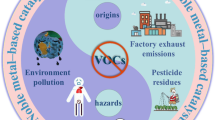Abstract
The effective treatment of volatile organic compounds (VOCs) is essential because of their direct effects on air pollution and human health. This paper introduces microwave-induced metal discharge as a highly effective and byproduct value-added approach to degrade high-concentration toluene as a model VOC. The effect of the factors that influence the discharge intensity, including the metal type (Fe, Cu, Ni, Zn) and amount, was investigated. Degradation efficiency of toluene can reach 79.76% under optimal discharge condition. In addition, the discharge method was compared with traditional thermal destruction at 700 °C, 900 °C and 1100 °C. The gaseous and liquid cracking products of toluene produced by the microwave-induced metal discharge method were almost similar to those obtained under thermal destruction at 900 °C; however, the solid-phase discharge products were nanoparticles that demonstrated good graphitization, while the thermal destruction products were amorphous microparticles. This work offers an effective and flexible way to degrade high-concentration VOCs and also provides an application reference for biomass tar cracking and removal of other organic pollutants.









Similar content being viewed by others
Change history
27 August 2021
A Correction to this paper has been published: https://doi.org/10.1007/s42768-021-00078-9
References
Zhang S, You J, Kennes C, et al. Current advances of VOCs degradation by bioelectrochemical systems: a review. Chem Eng J. 2018;334:2625–37.
Padalkar AV, Kumar R. Removal mechanisms of volatile organic compounds (VOCs) from effluent of common effluent treatment plant (CETP). Chemosphere. 2018;199:569–84.
Thevenet F, Debono O, Rizk M, et al. VOC uptakes on gypsum boards: sorption performances and impact on indoor air quality. Build Environ. 2018;137:138–46.
Mahbub P, Goonetilleke A, Ayoko GA. Prediction model of the buildup of volatile organic compounds on urban roads. Environ Sci Technol. 2011;45:4453–9.
Song CB, Liu BS, Dai QL, et al. Temperature dependence and source apportionment of volatile organic compounds (VOCs) at an urban site on the north China plain. Atmos Environ. 2019;207:167–81.
McDonald BC, de Gouw JA, Gilman JB, et al. Volatile chemical products emerging as largest petrochemical source of urban organic emissions. Science. 2018;359:760–4.
Abis L, Loubet B, Ciuraru R, et al. Profiles of volatile organic compound emissions from soils amended with organic waste products. Sci Total Environ. 2018;636:1333–43.
Rao G, Vejerano EP. Partitioning of volatile organic compounds to aerosols: a review. Chemosphere. 2018;212:282–96.
Churkina G, Kuik F, Bonn B, et al. Effect of VOC emissions from vegetation on air quality in Berlin during a heatwave. Environ Sci Technol. 2017;51:6120–30.
Cheng Y, He HJ, Yang CP, et al. Challenges and solutions for biofiltration of hydrophobic volatile organic compounds. Biotechnol Adv. 2016;34:1091–102.
Ran JJ, Qiu H, Sun SZ, et al. Are ambient volatile organic compounds environmental stressors for heart failure? Environ Pollut. 2018;242:1810–6.
Kim B, Lee YR, Kim HY, et al. Adsorption of volatile organic compounds over MIL-125-NH2. Polyhedron. 2018;154:343–9.
Filipiak W, Sponring A, Filipiak A, et al. TD-GC-MS analysis of volatile metabolites of human lung cancer and normal cells in vitro. Cancer Epidemiol Biomark Prev. 2010;19:182–95.
Gilman JB, Lerner BM, Kuster WC, et al. Source signature of volatile organic compounds from oil and natural gas operations in northeastern Colorado. Environ Sci Technol. 2013;47:1297–305.
Kamal MS, Razzak SA, Hossain MM. Catalytic oxidation of volatile organic compounds (VOCs)—a review. Atmos Environ. 2016;140:117–34.
MiarAlipour S, Friedmann D, Scott J, et al. TiO2/porous adsorbents: recent advances and novel applications. J Hazard Mater. 2018;341:404–23.
Bobbitt NS, Mendonca ML, Howarth AJ, et al. Metal-organic frameworks for the removal of toxic industrial chemicals and chemical warfare agents. Chem Soc Rev. 2017;46:3357–85.
Pan H, Jian YF, Chen CW, et al. Sphere-shaped Mn3O4 catalyst with remarkable low-temperature activity for methyl-ethyl-ketone combustion. Environ Sci Technol. 2017;51:6288–97.
More RK, Lavande NR, More PM. Copper supported on Co substituted hydroxyapatite for complete oxidation of diesel engine exhaust and VOC. Mol Catal. 2019;474:110414.
Rashidi R, Yousefinejad S, Mokarami H. Catalytic ozonation process using CuO/clinoptilolite zeolite for the removal of formaldehyde from the air stream. Int J Environ Sci Technol (Tehran). 2019;16:6629–36.
Sahle-Demessie E, Devulapelli VG. Oxidation of methanol and total reduced sulfur compounds with ozone over V2O5/TiO2 catalyst: effect of humidity. Appl Catal A. 2009;361:72–80.
Soreanu G, Dixon M, Darlington A. Botanical biofiltration of indoor gaseous pollutants—a mini-review. Chem Eng J. 2013;229:585–94.
Zhang GX, Liu YY, Zheng SL, et al. Adsorption of volatile organic compounds onto natural porous minerals. J Hazard Mater. 2019;364:317–24.
Jecha D, Brummer V, Lestinsky P, et al. Effective abatement of VOC and CO from acrylic acid and related production waste gas by catalytic oxidation. Clean Technol Environ Policy. 2014;16:1329–38.
Oliva G, Angeles R, Rodriguez E, et al. Comparative evaluation of a biotrickling filter and a tubular photobioreactor for the continuous abatement of toluene. J Hazard Mater. 2019;380:120860.
Malesevic A, Vitchev R, Schouteden K, et al. Synthesis of few-layer graphene via microwave plasma-enhanced chemical vapour deposition. Nanotechnology. 2008;19:305604.
Garcia MC, Mora M, Esquivel D, et al. Microwave atmospheric pressure plasma jets for wastewater treatment: degradation of methylene blue as a model dye. Chemosphere. 2017;180:239–46.
Lu ZY, Yu ZH, Dong JB, et al. Facile microwave synthesis of a Z-scheme imprinted ZnFe2O4/Ag/PEDOT with the specific recognition ability towards improving photocatalytic activity and selectivity for tetracycline. Chem Eng J. 2018;337:228–41.
Wang D, Peng Y, Xiong SC, et al. De-reducibility mechanism of titanium on maghemite catalysts for the SCR reaction: an in situ DRIFTS and quantitative kinetics study. Appl Catal B. 2018;221:556–64.
Bo XK, Xiang K, Zhang Y, et al. Microwave-assisted conversion of biomass wastes to pseudocapacitive mesoporous carbon for high-performance supercapacitor. J Energy Chem. 2019;39:1–7.
Fan LL, Chen P, Zhang YN, et al. Fast microwave-assisted catalytic co-pyrolysis of lignin and low-density polyethylene with HZSM-5 and MgO for improved bio-oil yield and quality. Bioresour Technol. 2017;225:199–205.
Jamroz P, Kordylewski W, Wnukowski M. Microwave plasma application in decomposition and steam reforming of model tar compounds. Fuel Process Technol. 2018;169:1–14.
Sun J, Wang Q, Wang WL, et al. Novel treatment of a biomass tar model compound via microwave-metal discharges. Fuel. 2017;207:121–5.
Hussain Z, Khan KM, Hussain K. Microwave-metal interaction pyrolysis of polystyrene. J Anal Appl Pyrolysis. 2010;89:39–43.
Wang WL, Liu Z, Sun J, et al. Experimental study on the heating effects of microwave discharge caused by metals. AlChE J. 2012;58:3852–7.
Zhou YL, Wang WL, Sun J, et al. Direct calorimetry study of metal discharge heating effects induced by microwave irradiation. Appl Therm Eng. 2017;125:386–93.
Sun J, Wang WL, Yue QY, et al. Review on microwave-metal discharges and their applications in energy and industrial processes. Appl Energy. 2016;175:141–57.
Undri A, Meini S, Rosi L, et al. Microwave pyrolysis of polymeric materials: waste tires treatment and characterization of the value-added products. J Anal Appl Pyrolysis. 2013;103:149–58.
Sun J, Wang WL, Liu Z, et al. Recycling of waste printed circuit boards by microwave-induced pyrolysis and featured mechanical processing. Ind Eng Chem Res. 2011;50:11763–9.
Gutmann B, Schwan AM, Reichart B, et al. Activation and deactivation of a chemical transformation by an electromagnetic field: evidence for specific microwave effects in the formation of Grignard reagents. Angew Chem Int Ed. 2011;50:7636–40.
Basheer N, Hussain K, Khan KM, et al. Gas chromatographic-mass spectrometric analysis of the products obtained by microwave-metal interaction pyrolysis of coal. J Chem Soc Pak. 2010;32:786–9.
Sun J, Wang Q, Wang W, et al. Plasma catalytic steam reforming of a model tar compound by microwave-metal discharges. Fuel. 2018;234:1278–84.
Sun J, Wang Q, Wang WL, et al. Exploiting the photocatalytic effect of microwave-metal discharges for the destruction of a tar model compound. Energy Fuels. 2018;32:241–5.
Funding
This work was generously supported by the National Key Research and Development Program of China (Grant No. 2018YFB0605200), Natural Science Foundation of China (Grant No. 51976110), Young Scholars Program of Shandong University (Grant No. 2018WLJH75), Fundamental Research Funds of Shandong University (Grant No. 2017GN009), and Natural Science Foundation of Shandong Province (Grant No. ZR2019MEE035).
Author information
Authors and Affiliations
Corresponding authors
Additional information
Publisher's Note
Springer Nature remains neutral with regard to jurisdictional claims in published maps and institutional affiliations.
Rights and permissions
About this article
Cite this article
Lv, Y., Zhou, Y., Wang, W. et al. VOC degradation by microwave-induced metal discharge and thermal destruction: a comparative study. Waste Dispos. Sustain. Energy 1, 261–270 (2019). https://doi.org/10.1007/s42768-019-00024-w
Received:
Revised:
Accepted:
Published:
Issue Date:
DOI: https://doi.org/10.1007/s42768-019-00024-w




